Centreon carried out its first State of IT monitoring with the assistance of independent firm Vanson Bourne. Collecting responses from 600 IT professionals in Europe and North America, the survey confirms the strategic importance of IT monitoring, the gap in maturity and contrasting approach to smart monitoring between Europe and North America, and the impact of infrastructure evolution on monitoring practices.
The bottom line of the survey in 3 key points
89% of respondents say IT monitoring is a high or top priority for their company.
Only 27% of respondents rate the visibility over IT performance levels as excellent, which might be explained by the fact that only 61% of the IT estate is monitored, on average.
Nearly 50% of IT managers responding believe that IoT (54%) and edge computing (44%) will have an impact on their monitoring practices by 2023.
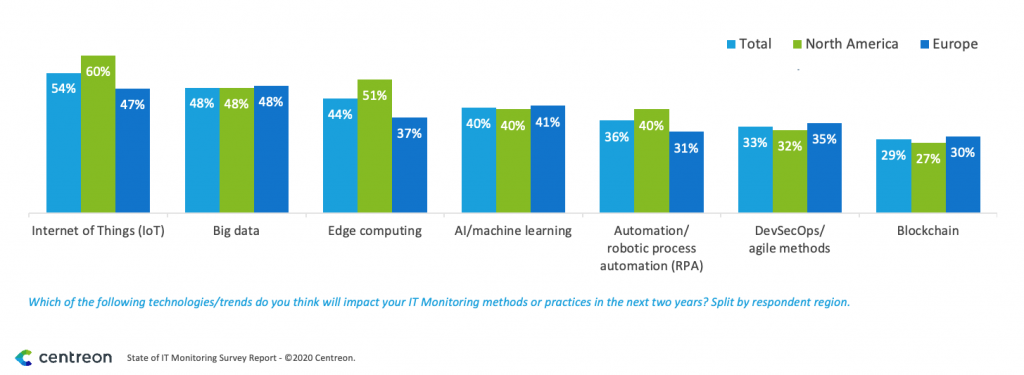
One of the main takeaways from the survey is that IT monitoring is (finally!) recognized as a prime topic in organizations. But this piece of good news should not cover up the fact that IT monitoring can (and should) still be improved to meet the new challenges of a constantly evolving IT environment.
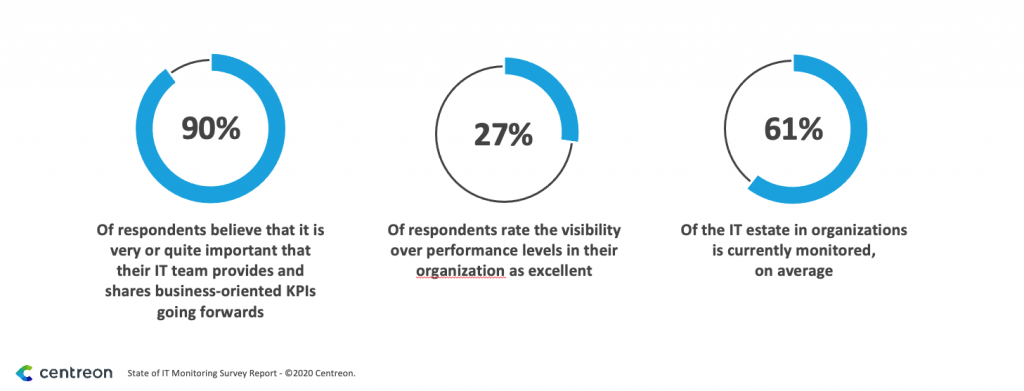
This year, budgets allocated to IT monitoring tend to increase, a trend which hasn’t been altered by the COVID-19 pandemic, quite the contrary.
ITOps are also aware that their monitoring practices need to evolve on two main axes: reinforcing the production of business-centric KPIs so that IT can be more in line with lines of business and integrating the cloud, edge and IoT into monitoring practices in order to provide a holistic view of the IT environment, wherever it is located.
IT monitoring is at the heart of digital business’ governance
The Centreon survey confirms how important IT monitoring is in the governance of digital businesses, despite a perceived lack of visibility on IT performance. It also highlights the increased investments and staffing in monitoring.
- For almost half of the companies surveyed, IT monitoring remains one of the three top budget priorities, the same as before the COVID-19 pandemic. IT monitoring is a key budget priority, particularly in North America.
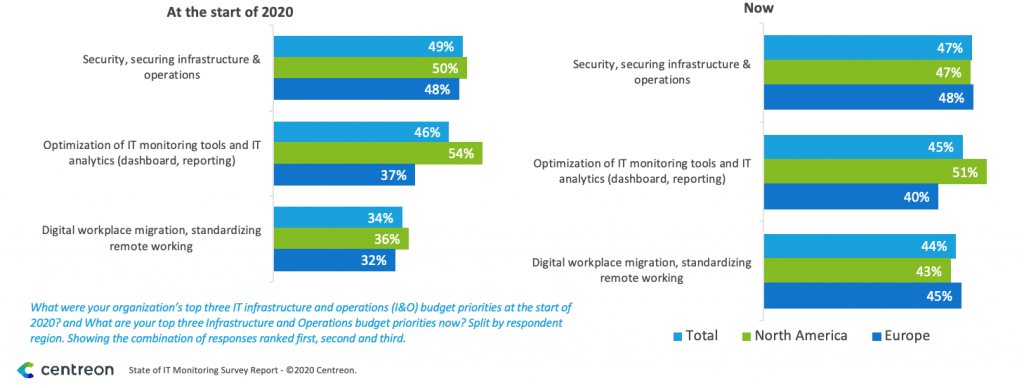
- IT and monitoring budgets have been positively impacted by COVID-19. IT budgets have increased in over half of organizations this year (52%), probably due to the expansion of the digital workplace. A positive aspect to point out: IT monitoring budgets have increased in almost as many organizations (49%).
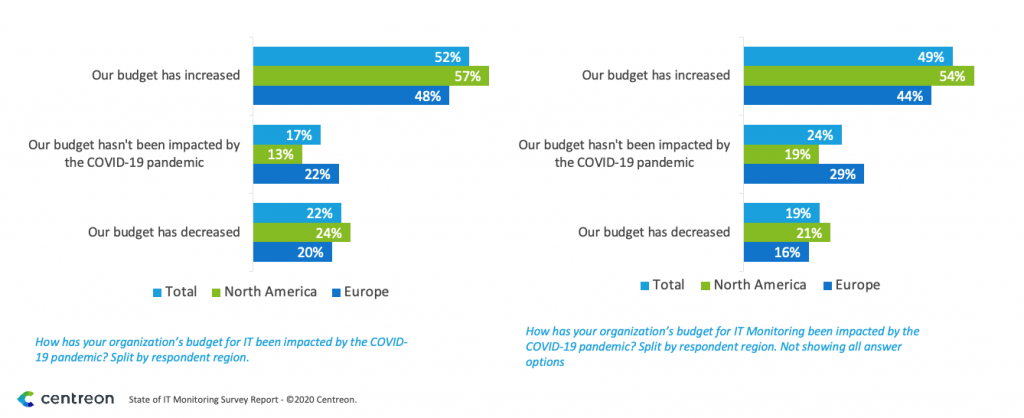
- IT monitoring is the field where companies are recruiting the most: 63% of them prioritize these recruitments, compared with 49% in security and 36% in networks.
A maturity gap on each side of the Atlantic?
The survey also shows a different approach between North American and European organizations, resulting in different priorities and practices.
- Europeans are slightly less inclined (46%) than North Americans (49%) to envision extending monitoring to the cloud, and foresee a greater increase in the share of cloud in their infrastructures by 2023.
- Europe seems to be lagging behind North America in adopting public cloud (22% for Europeans, 25% for North Americans) and edge and IoT (16% vs. 19%) although the survey does point to an overall upward trend over the next three years.
- Variations in priorities are likely due to a different pace in infrastructure development. Proof of this is North American companies identifying IoT (60%), edge computing (51%) and big data (48%) among the technologies and trends that will impact their IT monitoring practices by 2023, while Europeans list big data (48%), IoT (47%) and AI/machine learning (41%).
- In terms of staffing, we can see that North American IT managers are more immediately aware of the need to open new IT monitoring positions (73%), while their European counterparts may be lagging behind (51%).
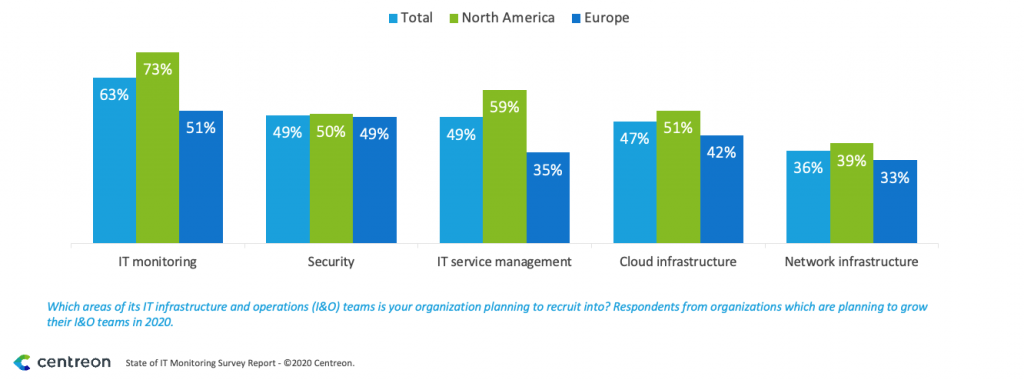
The impact on IT monitoring practices of the rise of IoT and edge computing and the willingness to share business KPIs
The study also reveals that the fast transformation of infrastructure, driven by the cloud, edge and IoT, is opening the door to the deployment of new monitoring practices. And that’s pretty good news! But it also means choosing IT monitoring solutions which can provide a holistic view of the IT system, a business-centric approach and which can be open to new infrastructure.
- One trend is evidently a source of satisfaction for us as a software publisher: the benefits of monitoring are clearly identified and recognized by IT teams. Among the praised benefits are improved team efficiency (50%), optimized IT budget (48%), improvement in the service provided (47%) and full visibility over IT infrastructure and operations (40%).
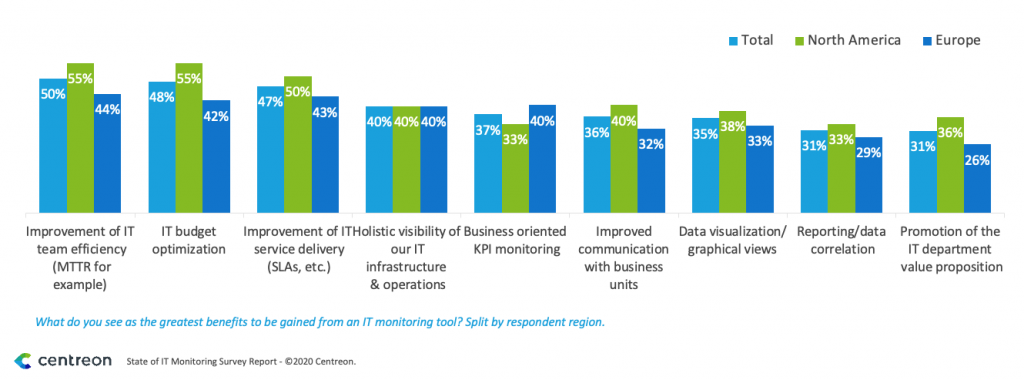
- 54% of IT managers surveyed list IoT as the trend that will have the greatest impact on their monitoring practices, compared to 48% for big data and 44% for edge computing (although there are regional differences).
- 90% of respondents believe that it is necessary for their IT team to provide business-oriented KPIs, confirming the importance of monitoring in managing digital business performance in the digital workplace era. In fact, one of the recognized benefits of IT monitoring is its ability to provide business-oriented indicators for 37% of respondents.
“As a major player in this market, we are not surprised by the results of this survey, which highlights the growing importance of IT monitoring. Trends in our business are like a wave that often moves from West to East, starting in the United States and ending in Asia. We are also aware of our role and responsibilities in supporting I&O on hot topics highlighted by the survey, such as a holistic view from cloud to edge and the necessity to be in line with the Lines of Business.” – Julien Mathis, co-founder and CEO Europe of Centreon.
Download our State of IT monitoring now. Based on an international survey commissioned by Centreon, this survey conducted by Vanson Bourne was carried out among 600 IT professionals in companies over 500 employees, in the following countries: the United States, Canada, France, Great Britain, Germany, Italy, Spain.





